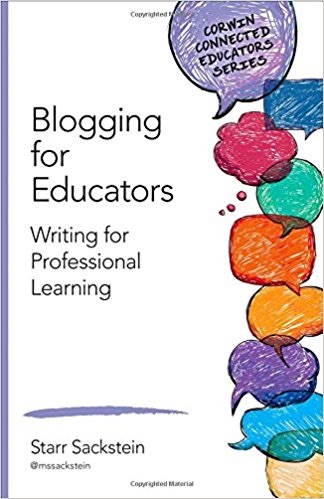
Blogging for Educators: Writing for Professional Learning by Starr Sackstein provides a strong rational for why educators should blog along with advice on how to get started. She is one of the best education bloggers I have found to date, and I explore the educational blogosphere every day. Be sure to click the icon at the bottom of any page to get copies for teachers you know.
Starr Sackstein
- Starr is a high school English and Journalism teacher at World Journalism Preparatory School in Flushing, NY. She is also the author of Teaching Mythology Exposed: Helping Teachers Create Visionary Classroom Perspective. She does a blog for Education Week called Work in Progress in addition to her personal blog at StarrSackstein.Com where she discusses all aspects of being a teacher. She moderates #jerdchat and #sunchat and contributes to #NYedChat. If you are looking for an energetic, high quality speaker on the subjects of blogging, journalism education, and bring your own device (BYOD), contact her at twitter (@mssackstein) or FaceBook.
Introduction
- Starr sees blogging as an important tool for educations leaders and students. Blogging adds virtual connections to writing, which is a vital part of communication. Sharing reflections and ideas with an audience can certainly richen one’s educational experience. Few educators, however, have been formally prepared with the necessary skills for teacher blogging, which is the main purpose of this book. This book should make it easier for you to help students reflect, develop metacognitive skills, foster an authentic voice, and develop a deeper understanding of their strengths and challenges.
1. Why Blog
- Starr starts by pointing out that blogs are the natural evolution of diaries and journals. Anyone in the habit of daily entries is certainly a natural for blogging. The difference of course is that blogs by their nature are public. They generally also allow for comments, so they can be much more collaborative than their predecessors. To buy Starr’s argument you need to share her vision that regular blogging will enhance your writing and thinking ability as you gain stamina and an outlet for your creativity. It will also make you more accountable to your audience and allow opportunities for greater reflection.
- Like myself, Starr had help from someone who knew more about the technicalities of setting up a blog, so don’t feel bad if you do too. Most districts should have tech support to help you get thinks going. Perhaps an easier place to start is with a Twitter account. With a 140 character limit, Twitter is considered a microblog. Once you start you can follow your favorite news outlets, which can save you time. Also try to find educators with common interests to connect with. (Each day I post the Twitter names of top bloggers.) Look for opportunities to engage in Twitter chats. My favorite is #edchat. In addition to tweeting out your thoughts and opinions, you can seek help for others. The purpose for blogging in a teaching context is to expand your personal learning community (PLN).
- Make sure your tweets and posts avoid going off on a tirade, and back up your opinions. While it is easy to tweet every day, extended blog posts might be something you post less often. Keep in mind that once you start, students and parents will naturally find and follow you, so you might as well use your blog to connect them to what happens in your classroom and school. At the end of this chapter there are links and advice from other teachers who blog. Like all chapters, it also ends with reflection questions that you can consider yourself and discuss with others.
DrDougGreen.com If you like the summary, buy the book





